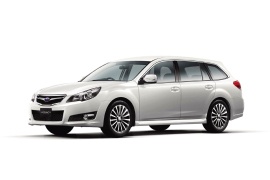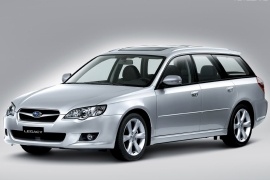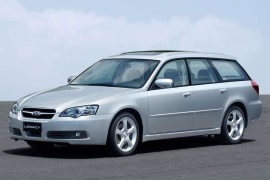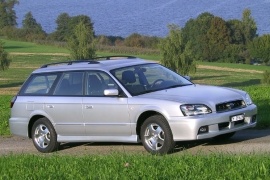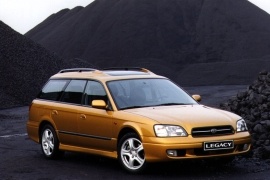SUBARU Legacy Wagon Models/Series Timeline, Specifications & Photos
First production year: 1998
Engines: Diesel, Gasoline
Body style: Wagon (station wagon, estate, combi, touring)
The fifth generation of the Subaru Legacy Tourer was unveiled at the 2009 New York Auto Show. It brought several new technologies for the 20 years model.
The first generation of the Subaru Legacy was launched in 1989 and it surprised the market with its all-wheel-drive and flat-four engine. It was a time when the smaller sibling, the Impreza, was winning races in the World Rally Championship and the Legacy success was based upon those winnings and its qualities.
One of the main features of the Legacy Tourer was the frameless side windows that were traditional for Subaru. The fifth-generation had to put frames to increase the car's safety to the newer standards. Its headlights were no longer slim but big and extended over the hood and fenders. The grille was bigger than before, with a chromed surrounding and the silver wings that sustained the oval badge. The car was longer than its predecessor by 55 mm (2.16”) and also by 40 mm (1.6”) than the sedan.
Inside, thanks to a big 17051 mm (108.3”) wheelbase, it offered enough legroom for the rear passengers. The longer roofline offered more headroom for the rear passengers as well. The trunk space could have been extended with the rear 60/40 split-bench folded up to 1677 liters (59.2 cu-ft)
The interior design was simple, with black and silver colors, that looked better than before. For the driver's comfort, the Legacy featured a dash-mounted parking brake and hill-holder.
For the technical department, the Legacy featured the same symmetrical all-wheel-drive system, with flat-four engines, either diesel or gasoline. The standard transmission was a 6-speed gearbox while a CVT named Lineartronic was offered as an option.
Subaru introduced a facelift for its mid-size lineup, the Legacy, in 2006, and, along with the sedan, it improved the station wagon version as well.
While its famous Impreza sibling just received its second facelift and started to look like a car, the Legacy didn't suffer from that since it was designed well from the start. Subaru noticed that it matched the design with the customers' preferences and didn't want to spoil the success with a new line or heavily improved headlights. Instead, it made slight aesthetic changes and decreased the number of engines available, making it easier to build.
Subaru took the "101 on how to facelift a car" and started to apply it on the Legacy, but it didn't read it all. It changed the headlights, which became softer on the edges, the bumpers that received fog lights, and the taillights, which received wider clear lenses for the reversing lights. Also, for specific versions, it added two exhausts.
Inside, the carmaker improved the sound system and offered an in-dash CD-changer unit. That meant that the center stack had to be redesigned and, since the design team had to work, it did it for the entire range. The team also made a few modifications on the instrument panel, which received red rings around the dials, as a reminder that the car was not just a regular "go-to-school" vehicle.
Under the hood, Subaru dropped some unwanted versions and introduced a 2.0-liter turbo-diesel flat-four engine. The European customers were happy about that since they asked for an oil-burner for years. The turbocharged 2.0-liter was deleted. Only the 3.0-liter naturally aspirated unit could go past the 200 hp barrier, which was not very popular on the European market but in high demand for U.S. customers.
Subaru introduced the fourth generation of the Legacy in 2003 and offered it in two body-shapes: a sedan and a station wagon, and both shared the same platform with the Tribeca SUV.
While its Impreza lineup was the car that decorated dorm-rooms and smashed rally stages all over the world, the Legacy was designed as a family sedan, but without forgetting about its racing achievements. In the station wagon shape, the Legacy looked more committed to providing everything a family needed in terms of cars.
Before the 2003 Legacy, there were just a few who liked Subaru's design. The Japanese carmaker looked like it paid high-money for the engineers and lunch-money for its designers. But the 2003 Legacy was different. It still kept the frameless doors, but it added an inspired front fascia with sharp, curved headlights. The grille sported the winged badge, while the front bumper featured a wide center air intake and four side vents. In the rear, Subaru made a raked-forward tailgate with a roof-spoiler on top of it, while the wide and low opening in the bumper allowed an easier loading and unloading from the trunk.
Inside, the low seating position reminded its occupants that they are in a Subaru, not into some kind of old-fashioned box on wheels. The front bucket-seats provided, depending on the version, high-bolstering. The carmaker installed a split-folding bench for up to three passengers in the rear, but with less room for the middle one since there was a transmission tunnel that crossed the station wagon from front to back.
Under the hood, Subaru installed its famous symmetrical all-wheel-drive system connected to a choice of five boxer engines ranged between 138 hp and 260 hp, depending on the market.
Subaru didn't want to waste too much time with facelifted versions and introduced the Legacy's third-generation after just six years from the second generation's launch.
By 2002 Subaru was already a known name among car enthusiasts, and the Impreza was a top contender in the World Rally Championship. For those who needed a good, reliable, spacious vehicle, the Japanese carmaker made the Legacy, and especially the Legacy Wagon. A car designed for families that offered all-wheel-drive safety and the comfort provided by independent suspension in all corners.
The carmaker improved the car's design, understanding that a good look will help a car sells better. Even though it wasn't everyone's vanilla, it showed that it tried to make it better. The bigger headlights and taller grille offered a better stance for the Japanese all-wheel-drive wagon.
Inside, the Japanese carmaker offered premium-segment details such as automatic climate control, leather seats, and plenty of room for five, despite the transmission tunnel that crossed the vehicle from front to back. Subaru asked the designers to install low seats to help in the corners with a lowered gravity center. For a good impression on long trips, the carmaker included a 6-CD changer as standard on the upper trim levels. Thanks to its rear split-folding bench, the Legacy Wagon provided up to 68.6 cu-ft (1942 liters) and a cargo area length of up to 6.25 ft (1.90 m).
Subaru installed a boxer engine under the hood mated to either a 5-speed manual or a four-speed automatic. A flat-six engine with a 3.0-liter displacement was available on selected markets only, and so was with the turbocharged 2.0-liter version. The turbocharged versions featured an air-intake on the hood for the intercooler.
Subaru tried to build a car that could compete against mid-sized station-wagons on the market with an all-wheel-drive vehicle that could do more than just taking kids to school and back.
While the Japanese carmaker was known for building trustworthy pickups for small farmers and rally-cars, another vehicle deserved more attention: the Legacy. It was available as a sedan and station wagon, as well as a more rugged version named Outback. The 1998 Legacy Wagon was part of the third generation of the Legacy lineup. It was a significant but less noticed evolution.
The carmaker understood that it couldn't go on with the same design and changed it for the better. Its bigger headlights and expressive grille were no longer subtle like it was a shame to be a Subaru. It looked bold and trustworthy. Its long roofline with a raked-forward tailgate completed a vehicle's image right for the family, not too aggressive and not too shy to go on long trips. One specific detail about the Subaru was the frameless window design, which was kept and it was unique on the market.
Inside, the Japanese carmaker offered premium-segment details such as automatic climate control, leather seats, and plenty of room for five. A generous sunroof was on the options list and lightened the cabin. The carmaker included a 6-CD changer as standard on the upper trim levels to make things even better.
Subaru installed a boxer engine under the hood mated to either a 5-speed manual or a four-speed automatic. A flat-six engine with a 3.0-liter displacement was available on selected markets only, and so was with the turbocharged 2.0-liter version.
